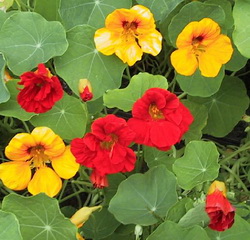Climbing Nasturtium
Climbing nasturtium is an excellent choice if you want a beautiful display on your garden trellis or up a short fence or wall. They do not produce their own tendrils so it is important that you provide them something for support. Common names for climbing nasturtium also include Tom Thumb, yellow lark's heels, dwarf and small nasturtium. These are smaller plants than those that are found in gardens but will beautifully branch out and climb up a variety of structures, giving you a splash of color for your garden area.
Heights of Climbing Nasturtium
Nasturtiums that climb are perennials while some other varieties are considered annuals. The climbing varieties thrive in cooler climates and can grow as high as ten feet tall in many cases. Climbing nasturtium are native plants to warmer locations such as Peru, Columbia, Ecuador and South America but are found commonly in the United States in many areas and climates. They are the perfect choice for hanging baskets and summer gardening as well as rock gardens as they are very versatile and can grow in the most neglected areas. They produce long stemmed leaves whose size depends on the specific species and the type of soil. Those planted in wetter areas tend to produce more foliage than blooms. If you prefer the leaves to the blooms then plant them in rich soil and water them often. Those wanting the beautiful colored blooms however should hold off on fertilizer and water only about once each week. Hummingbirds are very attracted to all species of nasturtium due to the nectar of the blooms as well as the vibrant colors. Potted climbing nasturtium can be grown indoors during the winter months to provide you with colorful blooms, lush foliage and the peppery flavor of the plant all year long.
Nasturtium Uses
The nasturtium plant has a variety of uses. Again, this is a very versatile plant that is completely edible. The leaves, flowers and seeds of the plant can all be used to provide a spicy flavor to a variety of dishes. Centuries ago, the climbing nasturtium was grown to produce ingredients used in herbal medicines. These medicines were used to stimulate appetites, counteract scurvy and to treat a number of other health conditions such as influenza, skin problems and various urinary infections. Because the leaves are rich in Vitamin C and iron, adding them to your cooking will help to ward off the common cold and other illnesses and help to prevent anemia. The most popular use today for climbing nasturtium is in cooking. The leaves are commonly added to various salads and soups and can be substituted for watercress. They can also be stuffed and chopped to be included in a variety of dips and sauces. The flowers are also edible and can be stuffed or chopped to use as garnish and flavoring for many dishes. Nasturtium seeds can be pickled and used as a substitute for capers, which are a bit more expensive than climbing nasturtium.
